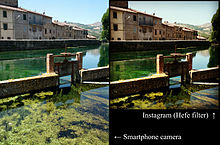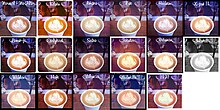Features and tools
Users can upload photographs and short videos, follow other users' feeds[84] and geotag images with longitude and latitude coordinates, or the name of a location. Every year, Instagram released Top 10 Instagram geotagged locations in the world, in pictures.[85] Users can connect their Instagram account to other social networking sites, enabling them to share uploaded photos to those sites.[84] As of June 2013, users can connect their Instagram accounts to Facebook, Twitter, Tumblr and Flickr.
In 2012, Instagram created web profiles which allows users to use their Instagram account like a social media site. This gave users a web profile featuring a selection of recently shared photographs, biographical information, and other personal details. The web feed is a simpler version of the phone app, mimicking the look and feel users are already accustomed to.[86]
In December 2013, Instagram added a feature named Instagram Direct that allows users to send photos only to a specific user or group of users, rather than having it be viewable by all. This was viewed as a response to the popularity of services like Snapchat.[87]
In August 2015, Instagram allowed users to start using non square images as part of the feature set.[88]
On October 29, 2015, Instagram announced that it would allow advertisers to buy carousel ads to expose company brands to more people.[89]
Explore Tab
The new explore tab was introduced in mid-2012 in which 21 photos are featured when a user clicks the tab second from the left on the bottom bar of the Instagram app. The photos must be of a public user whose profile is not set to private. This section of Instagram is where users can search for specific users or particular hashtags that interest them.
Filters
Instagram offers a number of photographic filters that users can apply to their images:
- Normal: No filter applied
- 1977: The increased exposure with a red tint gives the photograph a rosy, brighter, faded look.
- Amaro: Adds light to an image, with the focus on the centre.[90]
- Brannan: Increases contrast and exposure and adds a metallic tint.
- Earlybird: Gives photographs an older look with a sepia tint and warm temperature.
- Hefe: Hight contrast and saturation, with a similar effect to Lo-Fi but not quite as dramatic.
- Hudson: Creates an "icy" illusion with heightened shadows, cool tint and dodged center.[91]
- Inkwell: Direct shift to black and white - no extra editing.
- Kelvin: Increases saturation and temperature to give it a radiant "glow".[92]
- Lo-fi: Enriches color and adds strong shadows through the use of saturation and "warming" the temperature.
- Mayfair: Applies a warm pink tone, subtle vignetting to brighten the photograph center and a thin black border[93]
- Nashville: Warms the temperature, lowers contrast and increases exposure to give a light "pink" tint - making it feel "nostalgic".
- Rise: Adds a "glow" to the image, with softer lighting of the subject.
- Sierra: Gives a faded, softer look.
- Sutro: Burns photo edges, increases highlights and shadows dramatically with a focus on purple and brown colors.
- Toaster: Ages the image by "burning" the centre and adds a dramatic vignette.
- Valencia: Fades the image by increasing exposure and warming the colors, to give it an antique feel
- Walden: Increases exposure and adds a yellow tint.
- Willow: A monochromatic filter with subtle purple tones and a translucent white border.[94]
- X-Pro II: Increases color vibrance with a golden tint, high contrast and slight vignette added to the edges.
- Slumber: Desaturates the image as well as adds haze for a retro, dreamy look - with an emphasis on blacks and blues.
- Cream: Adds a creamy look that both warms and cools the image.
- Ludwig: A slight hint of desaturation that also enhances light.
- Aden: This filter gives a blue/green natural look.
- Perpetua: Adding a pastel look, this filter is ideal for portraits.[95][96]


No hay comentarios:
Publicar un comentario